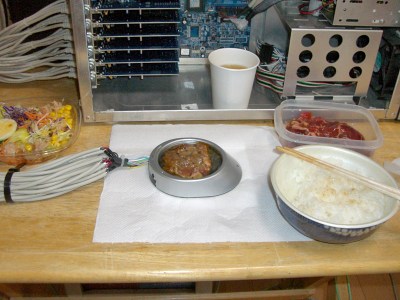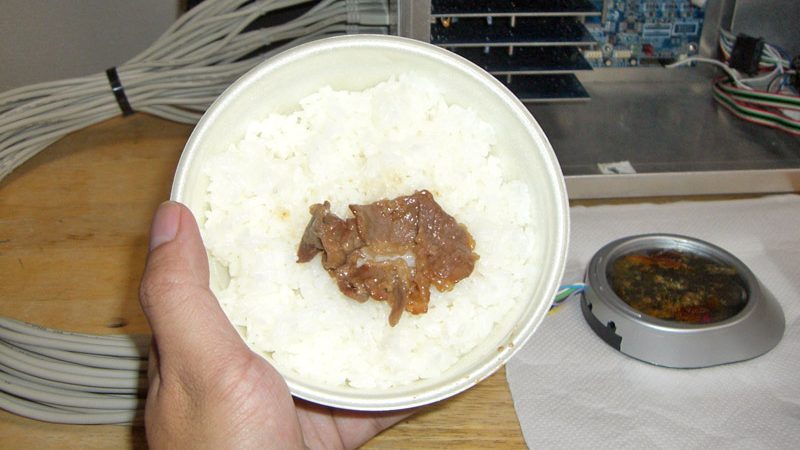Once upon a time, USB was still hip, cool, and easy to understand. You could get up to 500 mA out of a port, which wasn’t much, but some companies produced USB cup warmers anyway which were a bit of a joke. However, one enterprising hacker took things further back in 2004, whipping up a potent USB hot plate powered by a cavalcade of ports.

The project was spawned after a USB cup warmer sadly failed to cook a decent fried egg. To rectify this, a souped-up version was built. The cup warmer was stripped of its original hardware, and fitted with six 2-ohm resistors instead. At 5 volts, each would draw 2.5 amps and the total power draw would be on the order of 75 watts. Each resistor would thus need five USB ports to power it to stay under the 500 mA limit, for a total of 30 USB ports in total. Six PCI-to-USB cards were installed in a motherboard for this purpose, providing the requisite ports. A 500 watt power supply meant the computer had plenty of juice to run the hot plate.
Cooking proved successful, generating a decent amount of heat to brown up some beef. Served with some white rice, it proved an adequate meal, though apparently with a noted taste of electronic components.
This wouldn’t be such a challenge today. USB-C is capable of delivering 100 watts through a single port at 20 volts and 5 amps. However, there’s something joyous and charming about cooking on a ridiculous hotplate running off 30 USB 1.1 ports. The ingenuity is to be applauded, and it is truly a project of its time.

















I don’t know about ingenuity. More like dogged determination in the face of surmountable odds.
I remember someone working up a cupwarmer that used a 486 chip as the heating element, which was “awe inspring” in its own odd way. Now I actually have some 486 chips kicking around somewhere.
A 66Mhz Pentium 1 would’ve been the hot ticket back then. A Cyrix 5×86 that plugged into a 486 socket could get very hot. I got a nasty blister on the tip of my right little finger once when I barely brushed against the heatsink on one.
In the early 00’s some engineer at Polycom had the bright idea to move all the video processing out to the camera instead of relying on system resources. It was one of the first 30 FPS IP capable cameras out there, the on board processor also ran hot enough to warm a cold cup of coffee. Thing looked like something an evil business mogul would use.
I got to tour their lab right before they released the ViaVideo II and I kid you not, a few of the engineers had milled aluminum adapters to support coffee mugs on top of the cameras’ heat sinks. They tried to get the department head to push it forward as a feature but marketing didn’t think it would work.
Shame really, it was a neat system.
Waiting for the first USB-PD high-wattage cooking implements
Update – a USB-PD hotplate exists for soldering and not cooking https://www.adafruit.com/product/4948
Let’s not even start with USB 2.0. What doesn’t exist is any degree of widespread understanding of what type of USB 3.0 you actually have. What port? What type? Gen 1? Gen 2? PD? Type A? Type C? USB 3.1? USB 3.2? USB 3.2 Gen 2×2? Thunderbolt 3? Thunderbolt 2? Thunderbolt 1? USB4 Gen 2×2? USB4 Gen 3×2?
What color? White? Black? Blue? Teal? Red? Yellow? Orange? You might think I am joking but these are actually semi official colors. Or not exactly. More like not consistent colors that are not actually part of the specification.
You wonder why consumers are confused yet?
Well they say don’t cook s’mores on it if you’ve used for soldering:
https://youtu.be/heobl74rN88?t=479
So I guess cooking on it is fine if you’ve not soldered with it. And only if you are cooking something very small.
Yes i want a USB-PD powered device to cook me some Jamaican beef and cheese patties on the go!
Didn’t someone make a portable hot pocket cooker before?
Somebody climbed the mountain simply because it’s there :)
It must be cold on the mountain of vanity, to have to warm up cat food…
Somebody climbed the wrong mountain.
The “cup warmer” was widely misunderstood to mean it should actually boil you a cup of tea, but the real point was simply to keep the bottom of your mug slightly warmer to slow down the transfer of heat away from your drink.
Suppose you have 50 ml of tea left in the mug and it’s losing heat: 2.5 Watts out of your USB port counteracts the heat loss by about 0.7 C per minute, so 15 minutes later your tea would be about 10 degrees hotter than it would have been without.
is there any computer than does any of the higher voltages USB-C PD on any of it’s ports?
Gigabyte claim that their GA-Z170X-UD5 TH motherboard has one Type-C connector which does USB PD up to 36W, but there aren’t any more details than that, so I assume it’s 12V/3A? Aside from that, it seems to be PCIE add-in cards (e.g., again gigabyte have a GC-Titan Ridge add-in card which claims to do 20V/5A on one port).
It seems to be far easier (and cheaper?) to get a dedicated power supply/wall wart for it though.
Not that I’ll be the one to do it (time is my enemy, and I’ll be dead long before I fix that), but perhaps using system heat from any one of our PCs or Gaming systems to co generate enough to cook or heat up water in a useable fashion? I expect this has been done and thanks to HAD I’ll be rabbit holing on that research this morning.
Time to check the e-mail, cook an egg, and if I’m up for it, play call of duty while the smoker gets tonight’s dinner started.
I wonder how many watts of power could be saved if refrigerators and water coolers could dump their heat directly into the outdoors or domestic hot water.
People do this often for pool heating, using a desuperheater on their AC. It’s also common on ground source heat pump systems to have a DHW hookup.
I’ve had the thought of using all water cooled heat pumps on a common loop for all the heating and cooling needs of a household. It’s done on larger scale for district heating or just hydronics, but not often in homes.
I definitely remember reading about this on Slashdot about 20 years ago. Some guy made a little cup out of aluminium foil and put it on his CPU then crack an egg into the cup… I’m trying to remember what type, AMD Athlon maybe? I think it took close to an hour but eventually the egg went from clear to white and he called it a success.
https://dilbert.com/strip/2017-03-21
Not directy USB powered, but uses excess heat from the charger to heat your coffee!
Wally could have made million$.
I mean, you could do this just by using any Amazon.com USB-C doc that’s plugged into 2 monitors while charging a laptop.
what a waste, you know the psu has a 5v connector right?
I think the real waste is the joke flying clear over your head.
Yes, the PSU had 5v output without any extra parts, but that misses the point entirely. In case you’re not being sarcastic, the whole idea was to demonstrate in absurd fashion what you actually needed to build a USB POWERED cup warmer capable of boiling/cooking. It was in response to the strange expectations some people had for the regular usb cup warmers you could buy, they actually thought it should be able to boil water. Using the 5v PSU output wouldn’t have demonstrated visually how much power was being used in the same way as 30 USB ports all used to run one very small hotplate.
But again, whoosh!